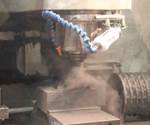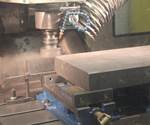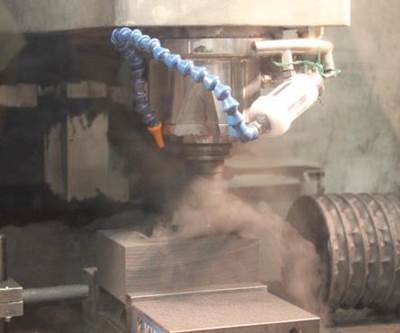Understanding the Total Package of the EDM Production Process Is the Key to Raising Productivity
The best way to determine the training best suited to your company is to find out what your customers need.
When Eric Roach was asked to be engineer for all the EDM projects at the Siemens Energy facility where he works, he knew it was a great opportunity—not only to move his career forward, but to expand his knowledge base. “I knew very little about how EDM truly works,” he says. “I only knew that EDM used electricity to remove material. I knew there was a lot more to understand.”
Today, Roach is Process Engineer/EDM - Machining/Air Flow - CMM at Siemens Energy in Rural Hall, NC, which produces turbines for fossil power generation. He filled his EDM knowledge gap with training provided by Poco Graphite, a division of Entegris.
This case study is just one example of how the right EDM training can raise productivity, and that includes within a mold manufacturing facility. POCO provides such training and technical information through its EDM Training Program free of charge. Classes are held at POCO Training Centers in North America, Europe and Asia; training can also be conducted at customer facilities.
The course Roach selected was “EDM Operation and Electrode Material Selection.” It was an eye-opener, he reports. “Learning about the number of variables you can control on the machine was very interesting, and to be able to leave the class with an understanding of each really helped our facility.”
At the training center in Decatur, TX, where Roach attended training, POCO’s EDM Laboratory makes it possible for students to perform test cuts to assess the performance of selected electrode/work metal combinations. They can also experiment with different machine settings to learn how to achieve the desired metal removal rate, surface finish or electrode wear.
Though Roach was the only process engineer from his location to attend the training, it has translated into a substantial productivity increase for the entire shop, he says. “I personally have been able to transfer this knowledge from the classroom to the production floor to decrease cycle times to a quarter of the original cycle time.
“During the development of new parts and repair processes you will have issues,” he adds. “During brainstorming sessions with colleagues, I’m able give valuable input on the EDM process since I now have a truer understanding of how EDM works.”
Since completing the training, POCO has supported Siemens with further training and assistance at the Siemens facility in Rural Hall, to help Roach put what he learned into action and further boost productivity.
“The training is set in a classroom environment with basic testing being conducted on our EDM sinker,” says Jerry Mercer, EDM Applications Manager at Poco Graphite. “While we try as much as possible, we often cannot duplicate exactly what attendees experience on their own shop floor. We offer the opportunity for companies to take advantage of ‘after training’ applications support (also provided at no charge) with an experienced POCO EDM Applications Specialist at the customer's location. This gives them the chance to take their training to the next level in a production environment, focused specifically on their own application with their own equipment. Often, we experience further productivity improvements.” POCO also offers an EDM Technical Manual available free of charge, by request, to anyone in the industry.
An Investment in Productivity
“Evolving customer demand” is often cited as an impetus for further training. Roach says that, for the Service Fossil business he works in, turnaround time is important. “We will always strive to give the customer a better part in the shortest amount of time. So, any time you can increase productivity it will, in the end, help the company meet these customer demands.”
According to Mercer, the key to raising productivity is to consider the “total package” of the EDM production process, including electrode material selection, application set-up (tooling, flushing, etc.) and machine parameter settings.
“When all three aspects to application are considered, the total outcome is almost always an increase in productivity. We teach our students to look at the application and treat each process separately in relation to key performance objectives. Each process in the application is broken down into individual segments to identify potential opportunities for improvement, and to discern how a change in one aspect affects the performance of another.
“We have had students with many years in front of an EDM sinker attend our training only to say that this was the first time they have understood exactly how the EDM process works,” Mercer adds.
Roach advises that the best way to determine the training best suited to your company is to find out what your customers need. “Just speak with your sales representative and talk to them about the issues customers are having–then make the decision based on those needs,” he says.
For his shop, the training has been an investment well worth his time. “The increased productivity you will be able to achieve after taking the class will easily exceed the cost of attending,” he says.
Related Content
Fundamentals of Designing the Optimal Cooling System
The right mold components can help improve mold cooling and thereby produce higher-quality parts.
Read MoreAdvantages and Disadvantages of Copper and Graphite Electrodes
Both copper and graphite provide approximately the same end result, so it is important for a shop to consider the advantages and disadvantages of each material in order to discover what would work best in their shop floor environment.
Read MoreHands-on Workshop Teaches Mold Maintenance Process
Intensive workshop teaches the process of mold maintenance to help put an end to the firefighting culture of many toolrooms.
Read MoreSolving Mold Alignment Problems with the Right Alignment Lock
Correct alignment lock selection can reduce maintenance costs and molding downtime, as well as increase part quality over the mold’s entire life.
Read MoreRead Next
How to Deal with Graphite Dust, Part 1
A review of the characteristics and considerations when handling graphite dust.
Read MoreHow to Deal with Graphite Dust, Part 2
A review of the explosive potential of graphite dust and how to dispose of remnants that may be accumulating around the shop.
Read MoreReasons to Use Fiber Lasers for Mold Cleaning
Fiber lasers offer a simplicity, speed, control and portability, minimizing mold cleaning risks.
Read More_970x90 1.png;maxWidth=970;quality=90)








_300x250 4.png;maxWidth=300;quality=90)



.jpg;maxWidth=300;quality=90)












